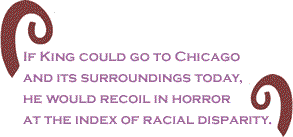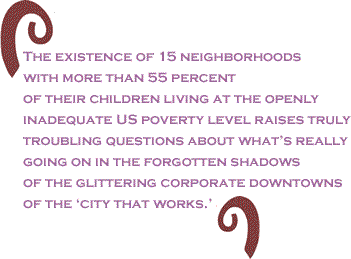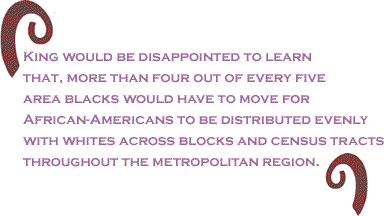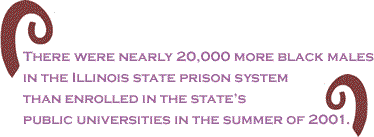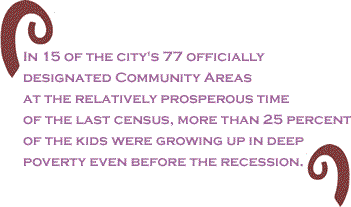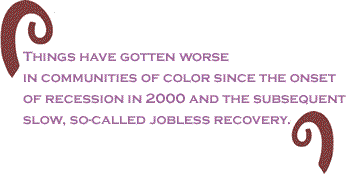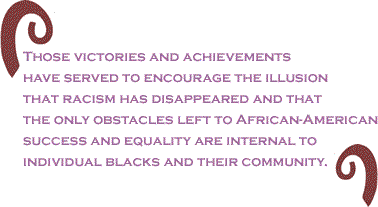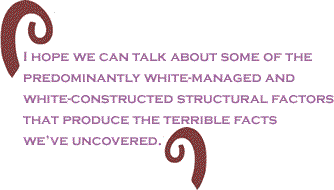
|
|||||||||||||||||||||
|
A shorter version of these comments was delivered at the South Side headquarters of the Chicago Urban League on June 21, 2005, in connection with the public release of Still Separate, Unequal: Race, Place, Policy, and the State of Black Chicago (Chicago, IL: The Chicago Urban League, 2005). Forty years ago, the great social justice leader Martin Luther King, Jr. and his colleagues in the Southern Christian Leadership Council came to Chicago determined to take the civil rights struggle to a radical new level. It was one thing, King told his colleagues, for blacks to win the right to sit at a lunch counter. It was another thing for black and other poor people to get the money to buy a lunch. It was one thing, King argued, to open the doors of opportunity for some few and relatively privileged African-Americans. It was another thing to move millions of black and other disadvantaged folks out of economic despair. It was another and related thing to dismantle slums and overcome barriers to equality that continued after public bigotry was discredited and after open discrimination was outlawed. It was one thing to get some black kids into formerly all-white schools. It was another thing to provide all black children with quality, integrated education. It was one thing to defeat the overt racism of snarling southerners like Bull Connor; it was another thing to confront the deeper, more covert institutional racism that lived beneath the less openly bigoted, smiling face of northern and urban liberalism. It was one thing to defeat the anachronistic caste structure of the South. It was another thing to attain substantive social and economic equality for black and other economically disadvantaged people across the entire nation. As many of you know, King left Chicago more than a little, yes, dissatisfied with the outcome of the movement’s efforts in the Second City. What would he see and think if he could magically return to Chicago four decades later? He would be disappointed to learn that, as we have found, the Chicago metropolitan area, has a black-white dissimilarity measure of 80.8, meaning that more than four out of every five area blacks would have to move for African-Americans to be distributed evenly with whites across blocks and census tracts throughout the metropolitan region. It would bother King to learn that within Chicago, 74 percent of black residents live in 22 neighborhoods that are 90 percent or more African-American – this, in a city that is home to 77 officially designated neighborhoods or community areas.
King would be intrigued to learn that blacks have recently gained unprecedented entrance to the suburbs and that one third of the metropolitan area’s black population now lives outside the central city. It would bother him, however, to lean that 70 percent of all suburban Chicago area blacks live in just one county and that more than half (52 percent) of all suburban Chicago area blacks reside in just 18 south suburban Cook County towns – this in a six country metropolitan area that is home to 265 local municipalities. Fifty one years after the Brown v. Board decision declared that “separate is unequal” and therefore unconstitutional in public education, King would be depressed to learn that 84 percent of black kids in the Chicago metropolitan area would have to switch schools for African-American children to be evenly distributed throughout the area's schools. Within Chicago, where two-thirds of the metropolitan area’s total black population – including three fourths of that population’s children – lives, the average black student attends a school that is 86 percent black. Two hundred and seventy four schools (or 47 percent) of the city’s 579 public elementary and high schools, are 90 percent or more African American and 173 of these schools – or 30 percent of all public schools in the city – are 100 percent black. King would be bothered by all this not because blacks have some special inherent need to live or study next to whites but because separate is unequal in a nation where crucial social and economic opportunities are not distributed evenly across and between place and jurisdiction. As the sociologist Douglass Massey notes, housing markets and residential patterns are important for racial parity because they distribute so much “more than a place to live; they also distribute any good or resource that is correlated with where one lives. Housing markets don’t just distribute dwellings, they also distribute education, employment, safety, insurance rates, services, and wealth in the form of home equity; they also determine the level of exposure to crime and drugs, and the peer groups that one’s children experience.” They distribute opportunity. Which raises the critical question of how the city and metropolitan area’s blacks are doing in terms of socioeconomic status, health, and position. If King could go to Chicago and its surroundings today, he would recoil in horror at the index of racial disparity we have culled from the 2000 Census and other sources. Moving from separate to unequal, he would be dissatisfied to learn that black median household income was just 58 percent of white median household income in the metropolitan area, according to the 2000 Census. It would upset him to learn that the median income of the average neighborhood inhabited by African-Americans in the Chicago metropolitan area ($36,298) is just 59 percent of the median income in the average neighborhood inhabited by whites in the same metropolitan area ($61,952).
He would be concerned to learn that the black population in and around Chicago is much more socio-economically “bottom-heavy” than the white population. The black metropolitan area income structure is built like a pyramid, with a wide base at the bottom and an increasingly narrow profile as one ascends to the top. As portrayed in the latest decennial census, the metropolitan white income structure is considerably more “top-heavy,” with larger percentages at the top and a narrower concentration at the socioeconomic bottom. While more than a third of the metropolitan area’s white households received an income of $ 75,000 or more per year, just 16 percent of the black households earned that much. More than a fourth of the region’s black households received less than $14,995, more than $1,700 less than the poverty level for a family of four in 1999. Less than a tenth of the area’s white households had incomes that low. As I’m sure many of you know, the official poverty measures in the U.S. have become an open joke among serious poverty and social policy researchers. According to the Economic Policy Institute, the real no-frills cost of a minimally decent “basic family budget” for a family of three in Chicago was $35,307 in 2001. Speaking of the poverty level, a fourth of the metropolitan area’s black households were officially poor in the 2000 Census, compared to just 5.6 percent white and 16 percent of Latin households. Sixteen percent of the central city’s blacks were living in what researchers now call “deep poverty” – at less than half of the federal government’s notoriously low and inadequate poverty level. King would be especially bothered by the child poverty measures in the census. He would be crestfallen to learn that more than a third of the metropolitan area’s black kids were living in poverty at the peak of the Clinton economic boom, compared to just 5 percent of the white kids. And then there’s the home-ownership, unemployment, prison, felony-marking, education, and health numbers. At 42 percent, the black home ownership rate in the region is 30 points below the white home ownership rates.
Fifteen of the metropolitan area’s blacks were officially unemployed, compared to 4.1 percent of whites and 8 percent of Latinos a the end of the 1990s. As I’m sure many of you know, the official unemployment rate significantly understates real unemployment and real black unemployment especially because it leaves out job-seekers who’ve given up and because it deletes involuntarily part-time workers and – of special significance for our story – the incarcerated. Two-thirds of the state’s more than 43,000 prisoners and more than 80 percent of its drug prisoners are African-American; this in a state that is just 15 percent African American. From 2000 through 2002, a quarter of the state’s released prisoners return to just 10 predominantly black zip codes on the West and South Sides and the number of black males carrying the lifelong mark of a criminal record was equivalent in absolute numbers to 42 percent of the city’s black male workforce at the turn of the century. There were nearly 20,000 more black males in the Illinois state prison system than enrolled in the state’s public universities in the summer of 2001. King would be especially struck by the new centrality of the mass imprisonment system in the creation and exacerbation of racial inequality in and around Chicago. At the time he was assassinated there were less than 8000 prisoners in the entire state of Illinois. Today’s top ten prisoner and prisoner release zip codes in Chicago together generate and receive considerably more prisoners than that each year. At least part of the problem is the dropout rate. We learned that just 4 in 10 black Chicago students graduate from high school in four years, compared to 6 in 10 white students and 8 in 10 Asian students. According to the latest research, at least 50 percent of all black male high school dropouts will be incarcerated at one point in their lives. Turning to health issues, we found that 24 percent of the state’s black residents lack health insurance, compared to 10 percent of its whites. Predominantly white Northwest Side Chicagoans can expect to live 75 to 80 years while predominantly black South Siders can expect to live to 60 years.
Another way to cut the data is to look at the racial composition of the Chicago neighborhoods that host the greatest concentrations of misery in the metropolitan area. It’s one thing to talk about metro- and city-wide disparities. It’s another thing to grasp the full dimension of interrelated, cross-cutting social, economic, and health difficulty in the worst-off community areas where poverty and its many toxic effects are most dangerously concentrated. There are 77 official community areas in Chicago. Of the city’s 15 richest among those 77 neighborhoods, all but two are disproportionately white. Of its 15 poorest communities, with average household incomes ranging from $11,000 to 28,000, all but 12 are very disproportionately black and none are disproportionately white. Of the 22 neighborhoods where 19 percent or more of rental households are spending 50 percent or more of their income on housing, all are 90 percent or more black. Of the city’s 15 highest unemployment neighborhoods, with jobless rates ranging from 18 to 34 percent, all are disproportionately black, including 12 that are more than 94 percent black. Of the city’s top 20 neighborhoods ranked for loss of manufacturing jobs between 1980 and 2000, all are disproportionately black and the great majority are more than 90 percent black. Of the 15 neighborhoods ranked by the Boston Consulting Group as the most “economically vital” neighborhoods in the city, all are disproportionately white. Fourteen of the bottom 16 neighborhoods for “economic vitality” are disproportionately black. By the way, those disadvantaged neighborhoods get the short end not just of economic health but also of private and public economic development funding dollars. Of the city’s 15 poorest neighborhoods, with poverty measures ranging from 32 to 56 percent, 14 are disproportionately black. Of the city’s top 15 neighborhoods for child poverty, with rates ranging from 55 to 71 percent – I said 71 percent – 10 are disproportionately black and none are disproportionately white, the rest being disproportionately Latino. In 15 of the city's 77 officially designated Community Areas at the relatively prosperous time of the last census, more than 25 percent of the kids were growing up in deep poverty even before the recession – at the peak of the Clinton boom. There were six neighborhoods – Oakland, North Lawndale, Washington Park, Grand Boulevard, Douglass, and Riverdale – where more than 40 percent of the children were deeply poor and in the last one (Riverdale) it was actually more than half. The only exception is the Near North Side, which had the 10th highest percentage of deep poverty kids and anyone who knows the city can tell you that's because of the presence there of the Cabrini Green housing project. All but one of these community areas has black population percentage that is considerably higher than the city average. All but three of them are at least 94 percent black. These are some things you won't read about, by the way in this big fancy book that has just been released by the Chicago Council on Foreign Relations – Global Chicago (2004) – with assistance from it's friends at the Chicago Tribune and the John D. and Catherine T. MacArthur Foundation and which has numerous glowing references to the glories of wonderfully global military-industrial corporate-welfare receiving Boeing Corporation – maker of the deadly B-2 Stealth Bomber and the savage Arab killing Blackhawk Helicopter, but no direct references to the uncomfortable, merely local pain and experience of thousands and thousands of black children living in the shadows of the great expanding world-connected corporate downtown and its growing ring of gentrifying condo complexes. The concentration of urban misery extends to health issues. Counter-intuitively for those who identify HIV and AIDS with white gay North Side populations, 13 of the city’s top 15 neighborhoods for HIV mortality are predominantly black communities on the South and West side. Twelve of the top 15 community areas for heart disease and ten of the top 15 for diabetes are disproportionately black. Part of the health problem for African-Americans may be a shortage of full-service grocery stores selling fresh fruits and vegetables necessary for a good diet. Twenty of the city’s 23 Dominick’s are in disproportionately white neighborhoods. Thirty-three of the city’s 40 Jewel’s are in such predominantly Caucasian community areas. One of the most interesting and unpleasant things we did in our study is that we combined key statistics from the city’s 22 90-percent black neighborhoods, treating them as a collective “city within a city” and comparing this hyper-segregated black inner-city with the overall city and metropolitan areas. We found that the collective unemployment rate of the predominantly black 22 is nearly twice that of the city as a whole. One-fourth of the children in this predominantly black city within a city – home to three fourths of the city’s African-Americans – live in deep poverty. The official unemployment rate of these 22 neighborhoods is nearly twice that of the city as a whole. The poverty rate in these 22 neighborhoods is more than three times higher than that of the metropolitan area as a whole. It’s worth recalling these 22 neighborhoods together account for three fourths of the city’s black population.
When I talk about these and other numbers to reporters, they ask me which stands out as the worst, the most shocking. It’s hard to say with the 4 in 10 four-year graduation rate for black high school students and the 20,000 more black male prisoners in state prisons than in four year state university programs, but I guess I’d have to pick the child poverty and deep poverty numbers. The existence of 15 neighborhoods with more than 55 percent of their children living at the openly inadequate US poverty level raises truly troubling questions about what’s really going on in the forgotten shadows of the glittering corporate downtowns of the “city that works.” The presence of 14 predominantly black community areas where more than a quarter of children are living at less than half – less than half – is a savage indictment of the underside of business as usual in our celebrated, freshly anointed global city. The other shocking thing is that all these numbers, or most of them, all the socioeconomic numbers, come from the peak of the longest “peacetime” economic expansion since World War II – the long “Clinton boom” of the 1990s. Things have gotten worse in communities of color since the onset of recession in 2000 and the subsequent slow, so-called jobless recovery. We know for example, the black adult employment/population ration actually went below 50 percent in 2002 according to the Bureau of Labor Statistics. Of course, facts and findings are one thing. Frames and explanations are another. The really interesting and controversial question, for me at least, is …what does that dreaded word “racism” got to do with all this racial inequality, which continues despite and perhaps partly because of the very real progress that some African-Americans have made since the 1960s? The answer depends on who you talk to. I’m an atypical Caucasian. I work in a predominantly black organization and live in a relatively liberal, integrated neighborhood. For most of the people I talk to, the answer ranges from “everything” to “a lot.” As far as mainstream white society is concerned, however, the answer is “nothing” or next to it. Insofar as differences in wealth, income, security and general well being persist between blacks and whites (and nearly half of the white population thinks that blacks have pulled even with whites), the large majority of white Americans deny that anti-black racism is the cause. Many point to the elimination of numerous discriminatory laws and barriers as well as the passage of equal employment legislation and affirmative action as proof that American society “bent over backwards” to guarantee blacks equal opportunity. Convinced that racism is no longer a significant problem for blacks, most whites find the real barriers to black success and equality within the African-American community itself. If problems for blacks persist, many whites and some privileged blacks think it’s only because too many blacks engage in “self-sabotaging” behaviors. As white America sees it, every effort has been made to welcome blacks into the American mainstream and now they’re on their own. “We made the corrections” and now it’s up to you.
Our study’s position is that racism is part of the explanation but we think you have to be very clear about what you mean when you use a loaded word like racism. The main difficulty with conventional mainstream white wisdom on “race relations” is a failure to distinguish adequately between level-one racism, which I call overt open public bigotry and prejudice and what I call level two racism or the deeper racism, by which I mean underlying covert societal or institutional racism. Level one overt racism, which King encountered in Chicago in 1966, has a long and sordid history, but it has largely been defeated, outlawed and discredited in the US and even here in Chicago. The deeper, covert level of racism, however, involves the more impersonal operation of social and institutional forces and processes in ways that “just happen” but nonetheless serve to reproduce black disadvantage in the labor market and numerous other sectors of American life. These processes are so ingrained in the social, political, and institutional life of the city, the region, the state and indeed nation that they are taken for granted – barely noticed by the mainstream media and other social commentators. Richly enabled by policymakers who commonly declare allegiance to anti-racist ideals, this second, deeper form of racism has an equally ancient history that has more than simply outlived the explicit, open and public racism of the past and the passage of civil rights legislation that is justly cherished within and beyond the black community What processes of underlying, covert societal and institutional racism continue to generate blacks’ persistently separate and unequal status in and around Chicago? Here’s a short list: • widely documented racial bias in real estate and home lending that complement, reflect and empower the general reluctance of whites to live next door to blacks, all of which combine with disproportionate black poverty to keep blacks out of the metropolitan area’s highest-opportunity communities. • the proliferation of expensive, taxpayer-financed suburban roads and developments constructed on behalf of mainly white suburbanites far from the predominantly black inner city, which subsidizes white flight and takes critically needed economic resources and opportunities yet further from those who are most in need of it. • the funding of schools largely on the basis of local property wealth, which tends to favor whiter school districts over blacker districts, an especially big issue in Illinois, where per-student funding ranges from more than 20K per kid in Lake Forest to less than 7K per kid in many black south suburbs. • the excessive use of high-stakes standardized test-based neo-Dickensian “dill and grill” curriculum and related zero-tolerance disciplinary practices in predominantly black public schools • the hyper-concentration segregation of black children into segregated ghetto schools where frazzled teachers have to deal with oversized classes where as many as 90 percent of their kids are dealing with the special barriers to learning that come with extreme poverty and its effects. • rampant and widely documented racial discrimination in hiring and union-managed apprentice-training admissions • the racially disparate “War on Drugs” and the related campaign of mass black imprisonment and felony-marking, which is waged with such racially selective ferocity that two thirds of state’s 40-thousand plus state prisoners are African-Americans and more than 80 percent of the state’s drug prisoners are black even though blacks make up 15 percent of the state and are no more likely to use illegal drugs than whites. • the aggressive pursuit of welfare caseload reduction as a positive good in and of itself without concomitant efforts to increase economic opportunity in poor black communities, where it is not uncommon for less than half of the adult population to be now be attached to the workforce.
• the disproportionate investment of local public economic development funding dollars to communities that need assistance the least Ironically, covert, level two, institutional racism may actually be deepened by civil rights victories and related black upward mobility into the middle and upper classes (however limited) insofar as those victories and achievements have served to encourage the illusion that racism has disappeared and that the only obstacles left to African-American success and equality are internal to individual blacks and their community – the idea that, as Derrick Bell puts it, “the indolence of blacks rather than the injustice of whites explains the socioeconomic gaps separating the races.” It’s hard to blame people for believing that racism is dead in America when our public life is filled with repeated affirmations of the integration ideal and our ostensible progress towards achieving it and when we regularly celebrate great American victories over level one racism. There are [now] enough examples of successful middle-class African-Americans, Sheryl Cashin notes, “to make many whites believe that blacks have reached parity with them. The fact that some blacks now lead powerful mainstream institutions offers evidence to whites that racial barriers have been eliminated; the issue now is individual effort….the odd black family on the block or the Oprah effect – examples of stratospheric black success – feed these misperceptions, even as relatively few whites live among and interact daily with blacks of their own standing.” Episodes and events like the demotion of Trent Lott or the election of a black Mayor (Harold Washington in 1983) or a black U.S. Senator (Carol Mosley Braun in 1992 and Barack Obama in 2004) or City Hall’s criticism of racist sentiments on the part of certain white firemen offer ample opportunities for city, state, and national leaders to pat themselves on their collective backs for advancing beyond the primitive state of level-one racism even while they promote policies that dig the hole of institutional and societal racism yet deeper. For what it’s worth, this is something Martin King worried about a great deal near the end of his life. “Many whites hasten to congratulate themselves,” King noted in 1967, “on what little progress [black Americans] have made. I’m sure,” King opined, “that most whites felt that with the passage of the 1964 Civil Rights Act, all race problems were automatically solved. Most white people are so removed from the life of the average Negro,” King added, “there has been little to challenge that assumption.” This was the same year that King issued his eloquent call for passionate dissatisfaction.
It’s my observation over many years of talking about race and race issues with Americans and Chicago area residents and suburbanites most especially that Caucasians tend to know amazingly little about typical hard-working real-life working- and middle-class or poor black Americans. This has a lot to do, of course, with separatism: the fact that there is still so little actual contact between blacks and whites in a metropolis and nation where blacks and whites live in very significantly separate physical, mental, social and moral worlds. Another part of it, I think, has to do with the strangely dichotomized all-or-nothing image of black Americans that television provides, basically offering two versions of the typical African-American: on one hand, the super-successful superstar like Michael Jordan or Oprah or Colin Powell or Condi Rice; on the other hand, the super-predator black male gang-banging perpetrator that is so ubiquitous on the 10 O’ Clock News and which is a staple on these dangerously authoritarian police shows like COPS and the like. I hope there’s some press here to ask questions about our study and that some of those questions will be about our proposals and solutions. You know, they said in our dominant corporate media the 2004 election was decided on the basis of “moral issues.” I hope that 10 segregated black neighborhoods with more than 55 percent of their children living in poverty and 14 segregated black neighborhoods with more than 25 percent of their kids living in “deep poverty” qualifies as a front-page MORAL ISSUE. I hope we can talk about some of the predominantly white-managed and white-constructed structural factors that produce the terrible facts we’ve uncovered. I hope that discussion of “personal responsibility” for these facts includes the personal responsibility of all concerned, including those at the top as well those at the bottom of the city and metropolitan area’s steep and interrelated racial and socioeconomic pyramids. Thank you very much. Paul Street ([email protected]) is Director of Research and Vice President for Research and Planning at The Chicago Urban League. He is the author of Empire and Inequality: America and the World Since 9/11 (Boulder, CO: Paradigm Publishers, 2004); and Segregated Schools: Class, Race, and Educational Apartheid in the Post-Civil Rights Era (New York, NY: Routledge, 2005 [forthcoming]). You can order a copy of Still Separate, Unequal by e-mailing [email protected]. |
Your comments are always welcome. Visit the Contact Us page to send e-Mail or Feedback or Click here to send e-Mail to [email protected] e-Mail re-print notice
If you send us an e-Mail message we may publish all or part of it, unless you tell us it is not for publication. You may also request that we withhold your name. Thank you very much for your readership. |
| June 30 2005 Issue 144 |
|||||||||
|
|||||||||
|
|
|||||||||
| Printer Friendly Version | |||||||||
 |
|||||||||
 |
|||||||||
| |
|||||||||
| |
|||||||||






















